Abstract
Beyond time frame editing in video data, object level video editing is a challenging task; such as object removal in a video or viewpoint changes. These tasks involve dynamic object segmentation, novel view video synthesis and background inpainting. Background inpainting is a task of the reconstruction of unseen regions presented by object removal or viewpoint change. In this paper, we propose a video editing method including foreground object removal background inpainting and novel view video synthesis under challenging conditions such as complex visual pattern, occlusion, overlaid clutter and variation of depth in a moving camera. Our proposed method calculates a weighted confidence score on the basis of normalized difference between observed depth and predicted distance in 3D space. A set of potential points from epipolar lines from neighbor frames are collected, refined, and weighted to select a few number of highly qualified observations to fill the desired region of interest area in the current frame from video. Based on the background inpainting method, novel view video synthesis is conducted with arbitrary viewpoint. Our method is evaluated with both a public dataset and our own video clips and compared with multiple state of the art methods showing a superior performance.
1. Introduction
Video editing at the object level is a challenging task due to the difficulties of dynamic object region segmentation and novel view video synthesis. Inserting a new object or removing an unexpected object from a video are challenging but interesting tasks. In both tasks, background inpainting for filling a missing region after object removal is a critical part of realistic new video synthesis. The missing region has to be appropriately inferred from given background information in the video.
One of the familiar inpainting algorithms from single images is the exemplar-based approach introduced in References [1,2]. The exemplar-based approach generates quick inpainting outputs when the hole is comparatively small. On the other hand, it suffers from insufficient visual coherence globally for bigger holes. The most critical and important aspect of the video inpainting method is how consistently random holes are filled with appropriate information in both space and time dimensions. It can be performed by the single image inpainting approach which considers patches over the neighbour frame, taking into account the flow of motion information [3,4,5,6] or global-space time consistency optimized by the global minimization energy function [7].
The existing inpainting methods are not suitable for dealing with a video including dynamic objects and complex video scenes taken from a moving camera, which is common in many video clips captured by daily used devices like smartphones. To overcome such problems, inter-frame registration and respective pixel-wise calibration throughout the frames in a video are needed. Motion-based alignment techniques for inpainting are proposed in References [8,9,10,11]. These methods try to compute the motion information of each pixel or patch to find the flow of camera movement throughout the video. A robust and fast alignment between the cameras can be performed using Homography transformation calculated from sparse key-points. Homography-based approaches are usually suitable for video editing tools to handle the problem of camera movement [10,12]. However, the single Homography transformation matrix is not capable of estimating dense corresponding points of the missing region in video inpainting task.
In 3D video editing, inpainting methods show a reasonable performance when the measurement of 3D information is accurate. Inpainting in 3D space can be performed when accurate 3D translation matrix between frames is possible to be extracted. However, calculation of accurate transformation matrix with moving camera is not a trivial task, where scene space relationship among the frames benefits diverse 3D video processing [13]. A Homography based inpainting method introduced in Reference [10] considers 3D scene information having piece-wise planner geometry to remove a moving object from video taken with moving camera. To fill the background of moving object, they use a single source frame based information maintaining the consistency of background color. A region-based Homography approach is applied in video inpainting in Reference [12] with static and moving cameras. Considering the computational complexity of their methods, they consider the alignment between groups of neighboring frames. The alignment among the neighboring groups is calculated by minimizing an energy function of both spatial and temporal coherence. A sampling-based approach proposed in Reference [14] which allows to perform high quality video processing like denoising, super-resolution, inpainting, and deblurring. They consider the utilization of redundant scene information over the frames of video instead of improving a separate 3D scene information producing rather blurry inpainting results. And it requires human intervention to remove the foreground object point cloud from the scene to get the background depth.
Another important task in video editing is novel view synthesis. Reconstructing a different view image or video in computer vision is a challenging task. Over the past few decades, several Novel View Synthesis (NVS) methods have been introduced such as view warping [15] and interpolation [16]. An image-based rendering (IBR) by sampling a plenoptic function from a dense matrix of camera view was introduced in References [17,18,19]. These methods work well when input views are separated by larger baseline. Novel view synthesis becomes more challenging task with wider baselines due to scale change, 3D rotation and foreshortening effect of the objects. The idea of IBR based on the 3D modeling is introduced in Reference [20] using multi-view stereo. Because of impressive development of 3D reconstruction techniques from multi-view images [21], we can obtain a novel view image based on the target pose of camera as input. Rather than reconstructing dense point, Reference [22] takes advantage of the sparse point obtained from the Structure-from-motion combined with the segmented region where each segment is considered as a planar associated with homography transformation. Reference [23] proposes an improved pipeline of better representation of 3D scene for NVS.
In this paper, we propose a novel and robust video editing method under several challenging background situations like complex visual pattern, occlusion, overlaid object clutter, and depth variation observed from a moving camera which is the extension of previous work [24]. First, our method obtains 3D point cloud and camera translation matrix of video frames using a Structure From Motion (SfM) method. Based on the obtained 3D location of the camera for each frame, our method computes a confidence score relying on the normalized difference between the depth (observed distance) and 3D distance to the ray segment in 3D space (predicted distance). The difference between observed depth and prediction distance quantifies the confidence of the potential point. We collect all the points from the truncated epipolar line from neighbor frames and those points are called as potential points in our inpainting step. After collecting all potential points, we select a few highly qualified potential background points based on the confidence score. Then we apply weight and ranking on the selected highly qualified potential points to fill missing regions in video editing. Finally, we correct the noisy pixel by calculating the temporal coherence between inpainted frames. The sample result of our method is shown in Figure 1 compared with the state of the art method [14].
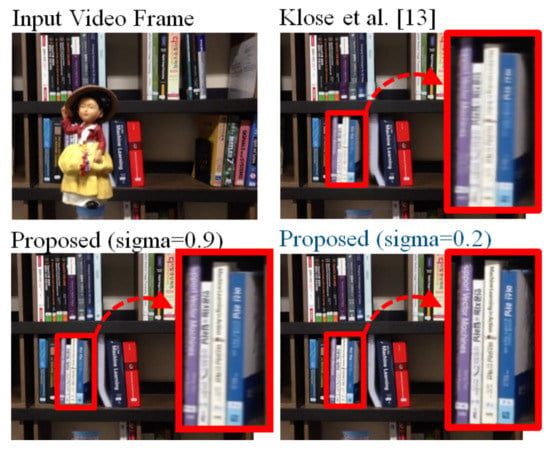
Figure 1.
Our video inpainting result compared to state of the art [14] method. More comparison results are demonstrated in Figures 13–15.
The contributions of our work include (1) a novel confidence score based on the normalized difference between depth and 3D distance to ray segment in 3D space (NDD) enabling simple but effective video editing in 2D image space, (2) a unified framework of optimal corresponding point collection for video editing that addresses occlusion, complex visual pattern, overlaid object clutter and depth variation problems in the background, (3) depth videos are calculated using photo-consistency over epipolar line of neighbour frames, (4) Our new view video synthesis using NDD produces the scene behind the foreground object to see background, (5) outperforming video editing results over state-of-the-art methods on both the public data set and our own video clips with various challenging conditions in novel view video synthesis.
2. Object Removal and Background Inpainting
Object removal and background inpainting in video are essential tasks in video editing. Our proposed background inpainting method is inspired by Reference [14]. The workflow of our object removal and background inpainting is shown in Figure 2.

Figure 2.
The workflow of our object removal and background inpainting method.
To inpaint background of each foreground object pixel of a current video frame, a pixel ray (dotted red line in Figure 3) is drawn in 3D space from the camera location which intersects both foreground object and background behind the object. We observes only the foreground object and the intersecting point with background (point b in Figure 3) is hided behind the foreground object. Background point b can be observed from some neighboring frames with a condition of a moving camera or moving objects.
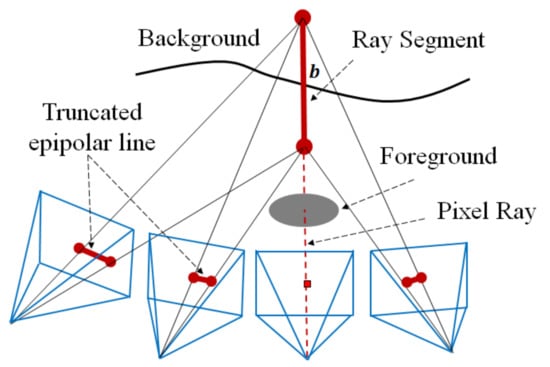
Figure 3.
Ray segment in 3D space intersect with background surface and corresponding truncated epipolar lines for potential background point collection from 2D reference frames of input video.
We truncate a segment of the pixel ray around the background surface which is shown in Figure 3 with a solid red line. As the background surface is unknown in the current frame, obtaining a good ray segment is very important in our method to include background information and avoid foreground information. We prefer the ray segment does not have any intersection with a foreground object that has to be removed. When the ray segment intersects with the foreground, our inpainting results will be corrupted by the foreground information. With other conditions, if the ray segment does not have any intersection with the background, our method fails to gather background information. Therefore, initially, we put the range of ray segments from a certain distance behind the foreground object to be removed to the farthest distance of the scene which makes sure of intersecting background.
Even though the initial ray segment is long, we optimize the range of the ray segment with the calculated normalized difference of depth-3D distance (NDD) in Section 2.2.1. We project the pixel ray shown in Figure 3 to 2D image plane using a transformation matrix calculated from SfM step and 2D plane observe a line called epipolar line. Each frame obtain a truncated epipolar line after projecting the ray segment to the neighbouring frame. Each 2D point on the truncated epipolar line is considered as a potential point for the background information extraction for the current frame. The background intersecting point exist on the truncated epipolar line unless the point is occluded by the foreground object which is shown in Figure 3.
Our method tries to find highly qualified points among the potential points on the truncated epipolar line. For each frame from input video , the binary mask is given to removed the object region from all frames from the input video. If the video of the mask was not given, we create the mask of the object from the video using method [25] where only 1st frame annotate mask is considered as an input. Point p represents the pixel of the foreground region that has to be removed which is decided from mask . Since the binary mask does not have to be so precise, we dilate the calculated mask to ensure every pixel of the foreground object should be considered for background inpaintng in our method. represents the color that is used to fill the point p after the foreground object removed. The main goal of our method is to estimate from the observation of neighboring frames. A potential set of points are used to calculate the for point p in current frame where points of all truncated epipolar line projected from pixel ray of point p}. represents color information of a potential point s (). Then is calculated as weighted sum of of all give.
where is a confidence score calculated from our normalized difference of depth-3D distance (NDD) that will be explained in detail in the following subsections. In fact, potential point set will be refined further in the following steps discarding explicitly poor potential points such as foreground point, background occluded points or outlier background point with a clearly different color.
2.1. Prepossessing
To remove an object from a video, we need a mask of an object in each frame of input video which indicates the desired region that has to be removed. In our method, we accept a given mask of all frames of input video, however we also can compute the mask of the object on all frames considering the mask of the first frame as input which is described in Section 2.1.1.
In order to calculate the truncated epipolar line at each neighboring frame, we need to know the camera transformation matrix between them. Using all video frames, we estimate the 3D point cloud and transformation matrix between frames from SfM (Structure from Motion) method [26] shown in Figure 4. With the given transformation matrix, a depth map of each frame is also obtained by calculating photo-consistency over the epipolar geometry or projecting the 3D points onto the 2-dimensional image space of each frame. The depth extraction methods are described in Section 2.1.2.
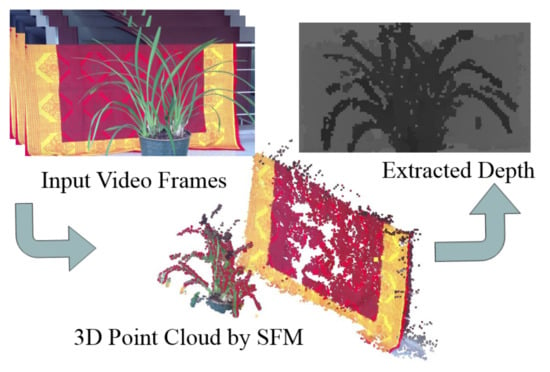
Figure 4.
3D point cloud and transformation matrix between frames are extracted from structure from motion (SfM) using all input video frames. Depth map of each frame is obtained by projecting 3D points and interpolating them at each 2D image space.
2.1.1. Object Mask Extraction
Segmenting a foreground object from a video sequence is an important task in video analysis and editing in commercial applications. An unsupervised method of foreground segmentation is a fully automatic method that does not need any human intervention. The main source of this kind of segmentation is visual saliency [27] and motion like optical flow [28]. However, foreground object segmentation in a video sequence is often an ambiguous task because of a desired object is not fixed. Therefore, unsupervised object segmentation does not apply to the interactive video editing scenario.
Rather than concentrating on the unsupervised method, we extract the object mask using a method described in Reference [25] with given a reference frame object mask and input video. The goal of this method is to segment the target object that has to be removed from the entire video sequence. To make use of both the previous mask to generate the current frame and the reference frame that specifies the target object, a Siamese encoder-decoder network is described in Reference [25].
2.1.2. Depth Extraction
The depth map of each frame is obtained by projecting the 3D points onto the 2-dimensional image space of each frame. The depth value at each pixel is calculated by interpolating the depth of projected 3D points falling within a patch of the fixed size described in Reference [24]. We simply perform a depth calculation for the points from overlaid multiple surfaces by selecting the closest group of points within the patch. If we do not have a large enough number of 3D points within the patch, we increase the patch size making a smoother depth map. In this case, sparse 3D points cause a big hole in the depth map and larger patch size causes poor depth near the edge of the object that has a noticeable difference in depth. On the other hand, the wrong 3D points cause noisy depth.
In order to find the depth of each pixel x, we draw a pixel ray that intersects the scene at a certain depth. The similar color observation of certain depth on the pixel ray from different given views can be potential depth of the output pixel of current frames . The ray that would be measured by the pixel denoted x in Figure 5 is marked by the red line passing through that pixel. To find the depth along the red line, we have to locate the position of the intersecting point between the red line and the scene on the basis of similar observation with pixel x from neighboring frames of the input video. In this context, the ray segment should cover the whole range of the scene to collect both the foreground or background information. We collect all observations of each point in the red line from different neighboring frames, which is shown on the right side of Figure 5. Along the red line, the highest photo-consistency observed from neighboring frames can be a potential location to measure of pixel x. However, it is a challenging task to find the depth location along the red line due to the presence of uniform area and occlusion in the scene when all neighbor frames are used to calculate the score of photo-consistency.
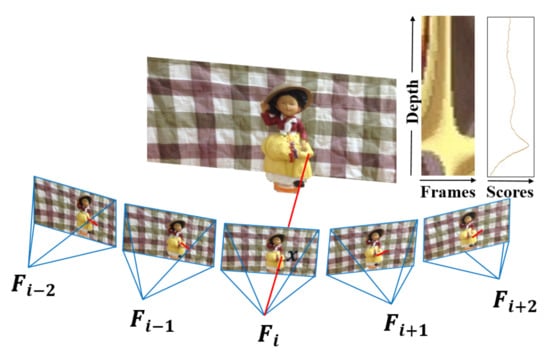
Figure 5.
Calculate the depth of pixel x from the similar observation from neighbouring frames along the epipolar line. Top right of the figure showing the color observed at a range of depth along the pixel ray across the neighbouring frames where depth is along the vertical axis and input frame along the horizontal axis. The minimum scores along the depth represent highest photo-consistency which represent the depth location for pixel x.
To avoid any occlusion, we divide the neighbouring frames into two groups (Left side frames and Right side frames) based on the location of the current frame. In Figure 6, the pixel x can be occluded either from the left-side or right-side neighbouring frames of input video from the current frame. In Figure 6, we carefully select four pixel , , and around the edge of an foreground object where and are on the foreground object and and are on the background of the scene. Pixel and is occluded from right and left side frames respectively from the current frame. Considering this fact, we calculate the photo-consistency score from the left frames and from the right frames shown in Equations (2) and (3) along the direction of depth z. We notice that, the highest photo-consistency is found for point from and point from along the depth z. The right and left side neighbouring frames are selected based on the 3D location of the neighbouring camera from current frames camera position. The pixel and can be observed from both left and right side frame and show the highest photo-consistency at same depth in and scores shown in Figure 6. To calculate , we use minimum scores from both and along the depth z which is shown in Equation (4).
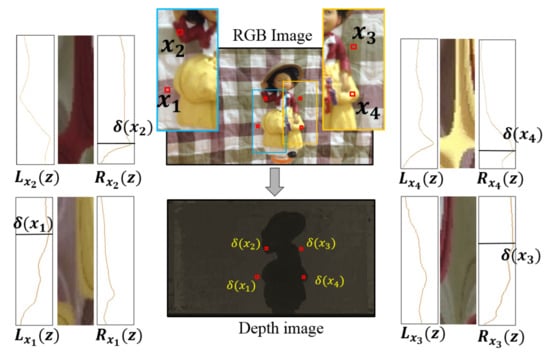
Figure 6.
Occlusion handling by calculate the photo-consistency scores considering either left or right side frames to predict the depth of pixel x.
Here, represents an image patch of current frame centered on the location where the 3D location along the ray of pixel x at depth z is projected. i is the index of current frame n is the number of left frames. We use equal number of frames for the left side and right side assuming uniform speed of camera motion.
2.2. Potential Point Set Collection
For image pixel p from the current frame, we collect a potential point set which includes all points on the truncated epipolar lines projected on neighboring frames from a pixel ray segment of p. In prior work [14], they consider a small frustum segment of pixel p and projected to neighbor frames that create a region rather than an epipolar line. They collect all potential points from the projected region for noise reduction and the object removal method consider the redundancy of color information with a lack of precise calculation of confidence for the output pixel. In our inpainting method for object removal, we propose a confidence scores based on NDD measurement step which enables us to select a very small number of highly qualified potential points out of point set . However, single pixel 3D frustum mostly is projected as a line in the 2D image and the most qualified potential points can be located in the near neighboring frames holding similar distance to the background surface along the lines.
Thanks to our precise NDD measurement and for light and effective algorithm, we draw a truncated epipolar line instead of a frustum. We collect all points that have less than 1 pixel distance from the truncated epipolar line from all neighbor frames constructing potential point set .
2.2.1. Normalized Difference of Depth-3D Distance
After collecting all potential points set from all truncated epipolar lines, we measure the confidence of each potential point by calculating the normalized difference between depth and 3D distance to the ray segment in 3D space (NDD). As the ray segment in 3D space is a parameterized line and the location of the current frame and neighboring frames are known, 3-dimensional Euclidean distance to the ray segment can simply calculate between two 3D points. A difference of depth-3D distance quantifies the discrepancy between the predicted distance (assuming that the current observed point is from the 3d position where background surface intersects ray segment) and depth (observed distance). In order to find the missing point behind the foreground object correctly, we have to know the corresponding position b of the background shown in Figure 7a which is the intersecting point between the ray segment and background surface. The depth-3D distance becomes zero at the position b where the ray segment lies as the red line and background are intersect each other.

Figure 7.
(a) Difference of depth-3D distance; (b) Normalized difference of depth-3D distance (NDD); (c) Threshold the NDD to refined the potential set of points.
In other words, if any potential point s is a correct observation of point b from the neighboring frame, the corresponding depth of point s and 3-D Euclidean distance between 3D point b and camera should be identical. However, the depth-3D distance of the same observed background from different view changes along with viewpoint changes shown on the right side of Figure 7a. So only depth-3D distance provides different confidence scores for the same point on background in neighboring frames with a different view. Therefore, we consider the normalized difference of depth-3D distance (NDD) as confidence scores shown in Figure 7b as a blue line and the calculation. NDD is the 3D distance along the perpendicular direction from the observed background to the ray segment. NDD still provides a linear measurement of the discrepancy between the depth (observed distance) and 3D distance (predicted distance) assigning consistent confidence scores for identical points. Figure 8a and Equation (5) demonstrate how NDD is really calculated in method [24].
where is depth of potential point s and . is approximated from the ratio between and (image space distance) and and (3d distance in camera space) as illustrated in Figure 8a. is 3d distance from s to light ray of current frame along the perpendicular line.
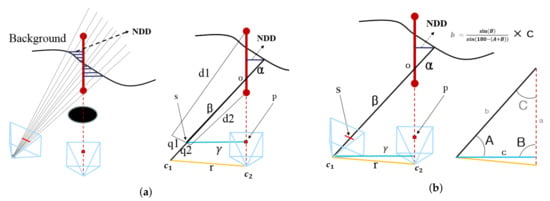
Figure 8.
(a) Normalized difference of depth-3D distance (NDD) calculation in method [24] based on the distance ration of and in epipolar line from image space; (b) NDD is calculated in 3D space from a triangle which is created by two camera position and and intersecting point o between pixel ray of point s and the truncated ray shown as red line.
However, in this method, the approximate NND distance is calculated from the ratio between and image space distance which is not compatible with the distance ratio in the 3D space. Instead of approximating the NDD distance from 2D space from Reference [24], we calculate NDD in 3D space which is illustrated in Figure 8b make our method more robust video processing having a different scale of depth in the scene. is calculate from the triangle created from two camera position and the point of intersection o between pixel ray of point p and pixel ray of point s (potential points for pixel p from truncated epipolar line from neighbouring frames). In the Figure 8b are two camera position in 3D space and the point o is the intersection between two pixel ray. So from given two line equation and two given camera position, we calculate . Finally the Equation (5) becomes
Here, A and B is the angle made by the triangle shown in Figure 8b at the camera position and respectively. is the perpendicular distance of camera position from the pixel ray of p.
2.2.2. Ray Segment Refinement
As the background point of ray-segment is unknown, the ray segment refinement step ensures to include the background point inside the ray segment. As we mentioned before, the initialization of the ray segment is not optimal. After calculating the NDD value for all potential points on the truncated epipolar line from a single frame, we obtain NDD distribution shown in Figure 7c. The optimal ray segment can be achieved by investigating the NDD distribution. First, we investigate the initial ray segment that really intersects with the background by observing the NDD distribution. If the ray segment intersects with the background, NDD distribution has to touch the horizontal axis (point index along the epipolar line) at least once. If the initial ray segment has no intersection with the background (Figure 9), we shift the ray segment along the direction where calculated NDD values become smaller (so that we can find the minimum point that intersects the horizontal axis). When the ray segment adjustment is finished, we farther optimize the size of the ray segment putting a threshold in NDD values shown in Figure 9.
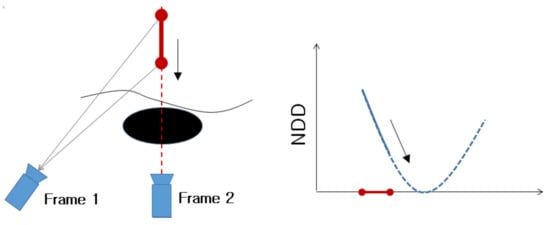
Figure 9.
Ray segment range shift: If ray segment does not intersect background, we shift our ray segment toward the side where calculated NDD values become smaller so that we can meet the minima point touching the axis.
As we know that high potential points for pixel p are located in the minimal point of NDD distribution, we drop all potential points that have bigger NDD values in S by giving a threshold. The size of a pixel in 3D space on the background surface is propositional to the depth of that pixel. We decide the potential points should have a smaller value than single pixel size in 3D. We can easily calculate the pixel size taking the rectangle size of a certain depth of pixel frustum.
2.2.3. Frame Selection
In the ray segment refinement step, we assume that our refined ray segments are located in a good position and have intersected with an occluded background. In the real world environment with complex shape background, neighboring frames could have failed to observe the desired occluded background even though the ray segment have an intersection with the background surface. However, we avoid the failure frames in our final inpainting calculation. In Figure 10, we have shown three failure cases where the desired background can not be observed.
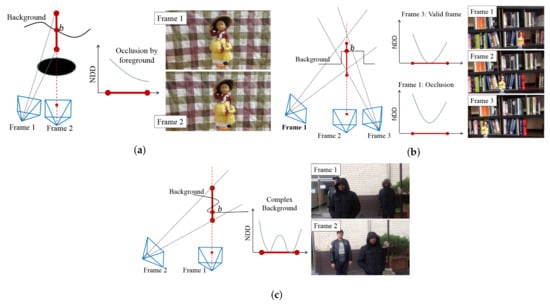
Figure 10.
Frame selection by investigating the distribution of NDD curve. (a) Invisible Background due to Close Foreground; (b) Self Occlusion; (c) Overlaid Object Clutter in Background.
Figure 10a is a “Invisible Background due to Close Foreground” case, where neighbor frames may not see occluded background b. This situation mostly happened with the nearest neighboring frames when the foreground object is bigger in size. If all points of the truncated epipolar line from a single frame consist of a foreground region, this frame is not considered for potential point collection. In this case, our NDD distribution curve does not touch the horizontal axis (point index along the epipolar line) and monotonically increases or decreases which indicates that the background point b can not be observed from this viewpoint.
Figure 10b is a “Self Occlusion” case. If the background contains very complex shape, desired background point b can be occluded by a different part of the background from the viewpoint of the neighboring frame. In this case, the NDD curve has a local minima point but never touches the horizontal axis. We have to discard this frame in the potential point collection step as well. For the detection of this situation, we compare the NDD score at the local minima of NDD curve with single 3D pixel size. If the score at local minima is smaller than single 3D pixel size then self-occlusion occurred on that frame. Figure 10c is a “Overlaid Object Clutter in Background”. In some case, the current frame has multiple backgrounds behind the foreground object at point p. In this situation, our NDD curve has multiple touches with the horizontal axis shown in Figure 10c. To inpaint the point p, we have to find the closest background point from the NDD curve. We choose the closest local minima point on the curve to collect the potential point for p and discard the farther minima points from the potential points collection.
Therefore, our frame selection step discards all potential points from the potential point collection step from the failure frames detected by the NDD curve. Finally, we get a refined and highly qualified potential point set qualified points on all truncated epipolar lines for point p of the current frame} for point p after performing both “Ray Segment Refinement” and “Frame Selection” steps.
2.3. Inpainting
After getting highly qualified potential point set , we perform inpainting step to get the background color information of point p using Equation (1). We give confidence score for all potential point based on the NDD values using the following equaiton:
where is the mean NDD of all and is the standard deviation of the Gaussian function. Figure 1 shows the effect of different . In our experiments, we set .
2.4. Temporal Error Correction
After calculating the color from Equation (1), temporal consistency between neighbour frames is investigated to correct noisy inpainting result. To simplify this step, we consider two consecutive frames. To correct the temporal error in the result, we calculate the global displacement between every consecutive frame. We believe that consecutive frames in a video have very Small displacement in the background pixel. We minimize the sum of squared distance between patches taken from both inpainted (background) regions from our proposed method. We get very small displacement between the frames in the subpixel level (1/4 pixel distance) because the movement between consecutive frames is very small. The image patch and the range of the search space are automatically selected based on the input mask of the foreground. After finding the global displacement, we estimate the noisy pixel based on the absolute difference between the inpainted pixel. Bigger differences between the pixel indicate temporal inconsistency. We replace the wrong pixel color values sequentially over the neighbor frame when the difference is big. However, it is very difficult to decide which alternate pixel color is correct in the inpaited result frame. We only trust the pixel outside of the inpainted region and the pixels that are replaced by non-inpaited pixel. This method sequentially corrects inconsistent error point passing over the correct value from outside of the inpainted region frame by frame. We employ this method to avoid any complex and computationally expensive global optimization with all inpainted points from all frames. If inconsistency happens suddenly in the middle of the inpainted background, the corresponding point at neighbor frames also could be non-corrected inpainted point as well (so we cannot trust any). In such a case, we trace back through further neighbor frames until we find either non-inpainted point or inpainted but corrected point. The effects of Temporal Error Correction in our background inpainting results are shown in Figure 11.
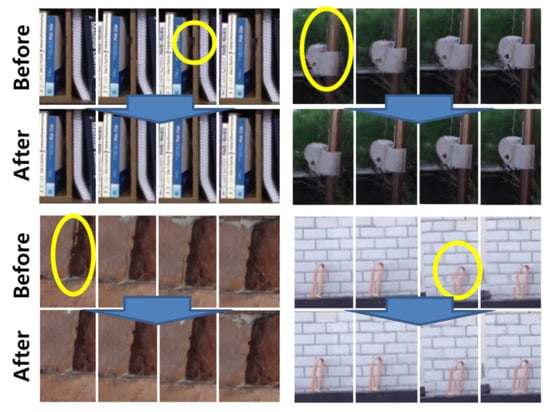
Figure 11.
Sample Temporal Error Correction Results: Please see inside of yellow circles.
3. Novel View Video Synthesis
In our proposed Novel View Video Synthesis (NVVS) method, we create a virtual camera in 3D space near the path of the input video. To render the novel view from the manually created virtual camera, we draw the pixel ray of pixel p of the novel view which intersects with the 3D scene. Here, the first intersection in the pixel ray from point p is considered as the potential position to collect color information from neighboring frames from potential points set using Equation (1). The point p represents the entire pixel of the view from the virtual camera created in 3D space. The only difference in the NVVS method from object removal is the truncated ray segment of pixel ray. To inpaint both foreground and background, the ray segment should cover the whole scene in 3D space which is shown in Figure 12a with a red line. In this figure, the pixel p need to collect color information of a smaller region from the closer object surface. On the other hand, the farther object surface in 3D space contains a bigger region for pixel p. The refined potential points should have a smaller distance than the region created by the frustum of single pixel p and the surface of the scene. As the NND curves do not always have zero minima, the smaller fixed threshold for NDD can avoid a potential frame for collecting refined point which can create artifacts when very few numbers of points are selected. On the other hand, a bigger threshold for NDD distance can include multiple refined points from the truncated epipolar 2D line from a single reference frame for a closer object shown on the left side of Figure 12a. Applying a bigger threshold on NDD causes a blur effect on the closer object and the background points near the object edge can collect foreground information. To solve this problem, we give a threshold based on the 3D distance from the novel view camera to the intersecting point between the pixel ray of p and pixel ray of s. The distance can be calculated from the triangle shown in Figure 8b. The diagonal Size of the single pixel frustum at distance from the Camera for each potential point s is considered as the threshold which forces collection of one or very few significant potential points from a single frame shown on the left side of Figure 12a. The distance ratio of the neighboring pixel in the epipolar line (image space) and the red line is not the same. In the valid range of the red line, closer distance has dense pixels and farther have a sparse pixels. If the threshold is set as single pixel size then some potential background pixel can be omitted from the refined point set collection. To include those, we consider the sub-pixel level inside the epipolar line of the 2D image rather than increasing the pixel size in 3D for threshold. In Figure 12b, we showed the comparison between the NVS result obtained from a fixed threshold and adaptive threshold based on the 3D distance. A fixed threshold creates a slightly blurred result when a bigger threshold is set for avoiding artifacts and our proposed threshold method based on 3D distance obtained more sharper result.
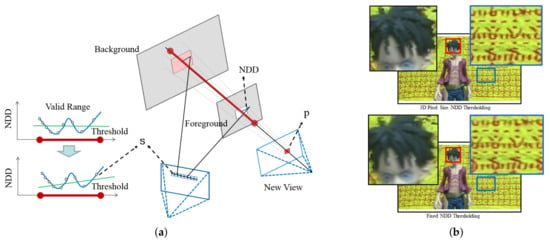
Figure 12.
NDD Thresholding to collect more potential points to reduce the effect of blurriness on Novel View Video Synthesis. (a) NDD Thresholding based on the 3D pixel size of estimated depth; (b) Comparison between 3D pixel size NDD thresholding and fixed NDD thresholding.
4. Experimental Result
To evaluate our video editing approach, we showed both object removal and novel view video synthesis results in our experiment. For object removal, We use two video data sets—public videos from Reference [10] and our own video clips. The public videos also contain the mask information of the desired object to be removed along with the mask of other moving objects present in the video. In the case of our own video clips, they mostly contain static objects with a bigger region and we extract the mask of the object to be removed using the method [25] described in Section 2.1.1. In our novel view video synthesis, we use our own video clips to create a novel view synthesized video.
The videos from the public background inpainting dataset [10] mostly contain far background, dynamic object, and regular patterns that have a small amount of camera movement. This dataset also provides the mask videos of desired object to be removed. This dataset contain seven real-world sequences. The videos are captured with hand-held Canon HV20 digital camcorder at 25 fps. Small camera movement is enough to observe missing background information of relatively small dynamic objects inside a video. However, in the case of the static object, we need a bigger camera movement to observe the missing background information. If we want to remove a bigger static object, we need more camera movement to secure the missing occluded background.
To simulate such cases, our video clips are taken mostly with closer patterned background and static foreground object using a hand phone. This is a challenging situation because we have large movement in the background that makes further degradation in inpainting performance due to the large change of viewpoint angle.
A comparison between Klose et al. [14] and our object removal method on diverse challenging videos are shown in Figure 13. Our inpainting method gives more clear results on first, second and fourth results. However, Klose et al. [14] produces blurred inpainting results due to the bigger holes which cause a larger movement of patterned background. A comparison between Klose et al. [14] and our object removal method on diverse challenging videos are shown in Figure 13. Our inpainting method gives more clear results on first, second, and fourth results. However, Klose et al. [14] produce blurred inpainting results due to the bigger holes which cause a larger movement of patterned background. To observe the background, if we need large camera movement then truncated epipolar lines in the far neighboring frames become bigger lines which cause more number of potential points.
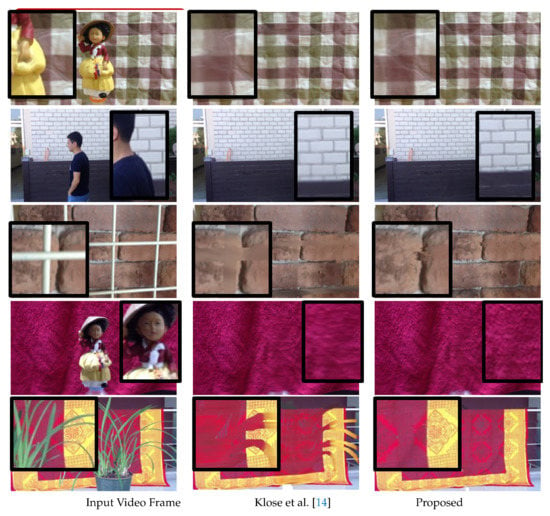
Figure 13.
Experimental results on our static foreground - closer background video clips to Klose et al. [14] method: previous work makes blurred and wrong results due to the large movement of close and patterned background.
A frustum is a pyramid structure view of a 2D camera and a pixel frustum represent the frustum view of single pixel of 2D camera. Klose et al. [14] collect all redundant points from their pixel frustum which creates a region in the neighboring frames. The region of the pixel frustum is bigger in size when the camera has larger movement. On the other hand, our method collects a very small number of highly qualified points from the truncated epipolar line based on our NDD score and produces clean and sharp inpainting results.
In Figure 14, we show all experimental results of the proposed method on our video clips taken from a handphone device. V1 has a close object with a bigger camera movement and complex visual pattern on the background. V2 also has a large camera movement with complex background shape so that many self-occlusion of background can be observed at different viewpoints. V3 has a moving foreground object with camera movement and v4 has a foreground with complex shape and the object is comparatively bigger. In V5, a narrow fence is the foreground object to be removed. With the fence object, if we have only the horizontal or vertical movement of the camera then some portion of the background is always occluded by the foreground. Therefore, we intentionally captured the clip with both vertical and horizontal camera movement to ensure every portion of the background is visible at least once in the video.
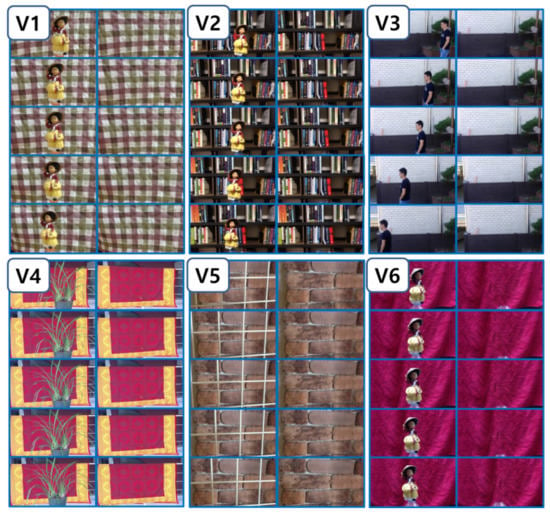
Figure 14.
Inpainted video clips by our method.
Figure 15 shows experimental results and comparison on the videos from Reference [10]. In most cases, our method provided more clean results than References [10,12]. However, Reference [10] gives blurred results in inpainting region.Dotted circles show that our method makes more clean inpainting results. Even though moving foreground object produces many wrong 3d points produced by SfM, the static background makes better inpainted region in our method. On the other hand, References [10,12] did not provide any result on static object inpainting where background information has to be collected from a bigger distance camera view.
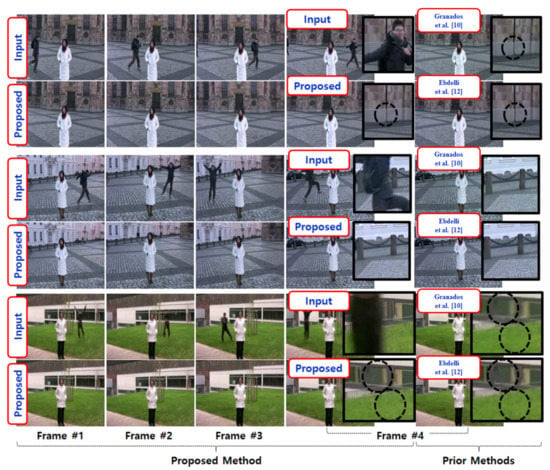
Figure 15.
Experimental results on publicly available data set with dynamic foreground with distant background by Reference [10].
4.1. Object Removal
Figure 16, we summarize multiple failure cases of our method. F1 has illumination change over the frame of a video clip. As we are collecting missing background point information of static objects directly from far neighboring frames based on our NDD calculation, different illumination conditions are used to fill that missing points. F2 and F3 have a complex background with multiple objects. In this situation, if a background object is located very close to the foreground object which is comparatively bigger in size, it becomes very difficult to observe the background. We need other viewpoint angles to observe the background. As a result, closer background objects can be also removed with foreground object and the farther background will be selected for background inpainting.
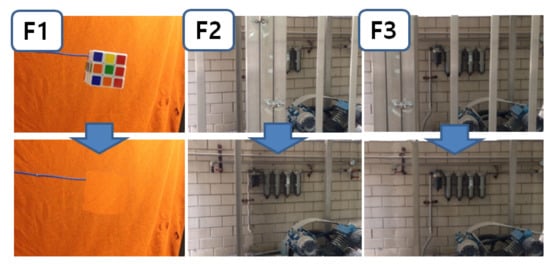
Figure 16.
Several failure cases in challenging conditions.
In our inpainting method, 3d points extraction from SfM is not precise sometimes. Even though our inpainting method produces clean and better result comparing with state of the art method proposing a confidence score and potential point qualification steps. However, if the background of the video is not static and contain a dynamic object other than the foreground object to be removed, SfM will not able to extract accurate 3D information for the dynamic background objects.
4.2. Novel View Video Synthesis
We evaluate our Novel View video Synthesis on our own video clips that mostly have a close object to obtain a large movement of an object along with the change of View. Figure 17 shows the results of our Novel view video synthesis where , , and are the few frames of input video. We create a virtual camera near the path of the input frame giving a translation along the direction of perpendicular to the camera movement. In Figure 17, , , and are the virtual camera created from near input frame having only translation along y-direction. and are translated in positive direction where and are translated in negative direction. The result of virtual view , and of our method shows that closer object movement is bigger than the farther object rather than the shifting the image along with the change of camera movement. , , , and are the virtual view cameras that are created with translation and rotation from . The novel view result of , and are shown in Figure 17.
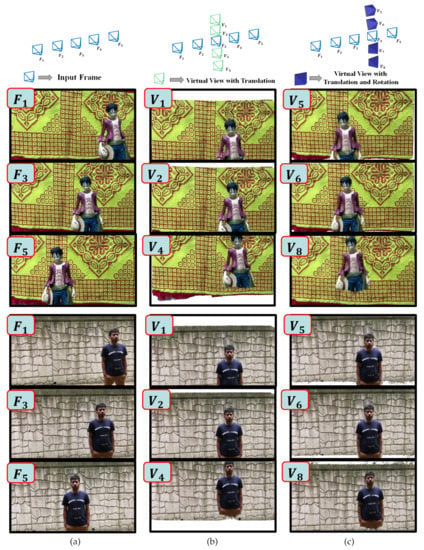
Figure 17.
Novel view synthesized video result where first column (a) is the input video sequence, second column (b) is the synthesized result of translated view along y direction, third column (c) is the synthesized result of translated view along y direction with rotation.
In our NVS experiment, we create virtual views and giving translation along z-axis toward the scene which is demonstrated in Figure 18. Here, virtual view is created in front of the foreground object and is created behind the object. The novel view result for shows that the background near the foreground object is occluded because of the view angle of the camera. This ensures that our method can produce a close view of a scene rather than zoom-in the original view. The result of is created behind the foreground object from where the only background of the scene can be observed. In this case, our NDD scores successfully collect background and avoid foreground points because the ray segments are positioned behind the foreground object.
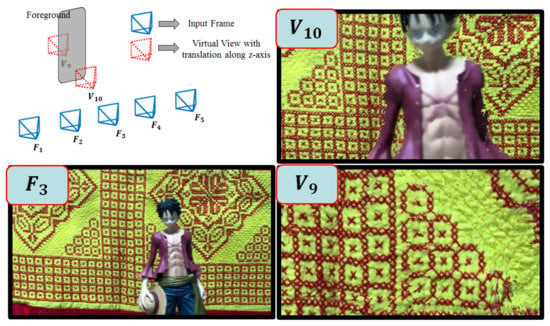
Figure 18.
Novel view video synthesis result of virtual camera moving toward the scene of video and virtual camera produces the scene behind the foreground.
It is very difficult to provide an objective evaluation of our novel view video synthesis method because we do not have the ground truth of novel view. Thus, to provide an objective evaluation, we consider any view of input video as novel view and inpaint the novel view without using that particular target view in our inpainting process. To calculate Peak signal-to-noise ratio (PSNR) and Structural Similarity Index Measure (SSIM), we collect 50 inpainted views and their respective original views from two video clips. Our inpainting method got an average PSNR 21.82 and SSIM 0.71. As our result have unpainted region in the border. So we exclude 15 pixel from the border in our PSNR and SSIM calculation. A comparison between inpainted view and original view are shown in Figure 19.
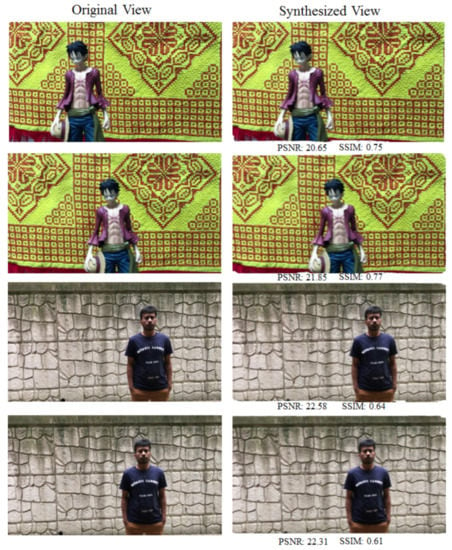
Figure 19.
Comparison between original view and synthesized view of our method.
Our NVVS depends on the extracted depth and the depth is created using photo-consistency over the epipolar lines of neighboring frame which lie on the direction of camera movement. Even though our method of depth extraction is not robust to the uniform color area, our NVVS method can render better results near the path of the input video. If the wrong depth is calculated in one reference frame, our refining method can ignore that point considering the color redundancy of the collected set of potential points. In the case of rendering a novel view video having a bigger distance from the path of camera movement, our method highly depends on the depth accuracy. These results show that our proposed inpainting method using NDD can be generalized for both object removal and Novel view video synthesis.
5. Conclusions
In this paper, we propose a robust video inpainting method. We calculate a normalized difference of observed depth and 3D distance over the video frames and find the potential qualified points to fill the missing region. Our method can fill the missing region by inpainting the background to remove an object from the video and also generate a totally novel view video from the input video. Experiments on both public and our own video data and comparison to state-of-the-art methods show promising video inpainting performance over diverse challenging conditions to remove foreground objects. For a generalization of our proposed inpainting method, we also perform Novel View Video synthesis, which shows encouraging results. However, inappropriate input of depth map and camera translation matrix estimation can be a cause of poor performance of our inpainting method.
Author Contributions
Conceptualization, A.S. and S.L.; methodology, A.S. and S.L.; software, A.S.; validation, S.L.; data curation, A.S.; writing—original draft preparation, A.S.; writing—review and editing, S.L.; visualization, A.S.; supervision, S.L.; project administration, S.L. All authors have read and agreed to the published version of the manuscript.
Funding
This research received no external funding.
Institutional Review Board Statement
Not applicable.
Informed Consent Statement
Not applicable.
Data Availability Statement
Not applicable.
Conflicts of Interest
The authors declare no conflict of interest.
References
- Criminisi, A.; Pérez, P.; Toyama, K. Region filling and object removal by exemplar-based image inpainting. IEEE Trans. Image Process. 2004, 13, 1200–1212. [Google Scholar] [CrossRef] [PubMed]
- Buyssens, P.; Daisy, M.; Tschumperlé, D.; Lézoray, O. Exemplar-based inpainting: Technical review and new heuristics for better geometric reconstructions. IEEE Trans. Image Process. 2015, 24, 1809–1824. [Google Scholar] [CrossRef] [PubMed]
- Barnes, C.; Shechtman, E.; Finkelstein, A.; Goldman, D.B. PatchMatch: A randomized correspondence algorithm for structural image editing. ACM Trans. Graph. 2009, 28, 24. [Google Scholar] [CrossRef]
- Shih, T.K.; Tang, N.C.; Hwang, J.N. Exemplar-based video inpainting without ghost shadow artifacts by maintaining temporal continuity. IEEE Trans. Circuits Syst. Video Technol. 2009, 19, 347–360. [Google Scholar] [CrossRef]
- Patwardhan, K.A.; Sapiro, G.; Bertalmío, M. Video inpainting under constrained camera motion. IEEE Trans. Image Process. 2007, 16, 545–553. [Google Scholar] [CrossRef] [PubMed]
- Shih, T.K.; Tan, N.C.; Tsai, J.C.; Zhong, H.Y. Video falsifying by motion interpolation and inpainting. In Proceedings of the IEEE Conference on Computer Vision and Pattern Recognition, Anchorage, AK, USA, 23–28 June 2008; pp. 1–8. [Google Scholar]
- Wexler, Y.; Shechtman, E.; Irani, M. Space-time completion of video. IEEE Trans. Pattern Anal. Mach. Intell. 2007, 29, 463–476. [Google Scholar] [CrossRef] [PubMed]
- Newson, A.; Almansa, A.; Fradet, M.; Gousseau, Y.; Pérez, P. Video inpainting of complex scenes. SIAM J. Imaging Sci. 2014, 7, 1993–2019. [Google Scholar] [CrossRef]
- Lin, W.Y.; Liu, S.; Matsushita, Y.; Ng, T.T.; Cheong, L.F. Smoothly varying affine stitching. In Proceedings of the IEEE Conference on Computer Vision and Pattern Recognition (CVPR), Providence, RI, USA, 20–25 June 2011; pp. 345–352. [Google Scholar]
- Granados, M.; Kim, K.I.; Tompkin, J.; Kautz, J.; Theobalt, C. Background inpainting for videos with dynamic objects and a free-moving camera. In Proceedings of the European Conference on Computer Vision, Florence, Italy, 7–13 October 2012; Springer: Berlin/Heidelberg, Germany, 2012; pp. 682–695. [Google Scholar]
- Liu, S.; Yuan, L.; Tan, P.; Sun, J. Bundled camera paths for video stabilization. ACM Trans. Graph. 2013, 32, 78. [Google Scholar] [CrossRef]
- Ebdelli, M.; Le Meur, O.; Guillemot, C. Video inpainting with short-term windows: Application to object removal and error concealment. IEEE Trans. Image Process. 2015, 24, 3034–3047. [Google Scholar] [CrossRef] [PubMed]
- Bhat, P.; Zitnick, C.L.; Snavely, N.; Agarwala, A.; Agrawala, M.; Cohen, M.; Curless, B.; Kang, S.B. Using photographs to enhance videos of a static scene. In Proceedings of the 18th Eurographics Conference on Rendering Techniques, EGSR’07, Aire-la-Ville, Switzerland, 25 June 2007; pp. 327–338. [Google Scholar] [CrossRef]
- Klose, F.; Wang, O.; Bazin, J.C.; Magnor, M.; Sorkine-Hornung, A. Sampling based scene-space video processing. ACM Trans. Graph. 2015, 34, 67. [Google Scholar] [CrossRef]
- Seitz, S.M.; Dyer, C.R. Physically-valid view synthesis by image interpolation. In Proceedings of the IEEE Workshop on Representation of Visual Scenes (In Conjunction with ICCV’95), Cambridge, MA, USA, 24 June 1995; pp. 18–25. [Google Scholar]
- Chen, S.E.; Williams, L. View interpolation for image synthesis. In Proceedings of the 20th Annual Conference on Computer Graphics and Interactive Techniques, Anaheim, CA, USA, 2–6 August 1993; pp. 279–288. [Google Scholar]
- Adelson, E.H.; Bergen, J.R. The Plenoptic Function and the Elements of Early Vision; MIT Press: Cambridge, MA, USA, 1991. [Google Scholar]
- McMillan, L.; Bishop, G. Plenoptic modeling: An image-based rendering system. In Proceedings of the 22nd Annual Conference on Computer Graphics and Interactive Techniques, Los Angeles, CA, USA, 15 September 1995; pp. 39–46. [Google Scholar]
- Levoy, M.; Hanrahan, P. Light field rendering. In Proceedings of the 23rd Annual Conference on Computer Graphics and Interactive Techniques, New Orleans, LA, USA, 4–9 August 1996; pp. 31–42. [Google Scholar]
- Scharstein, D. Stereo vision for view synthesis. In Proceedings of the CVPR IEEE Computer Society Conference on Computer Vision and Pattern Recognition, San Francisco, CA, USA, 18–20 June 1996; pp. 852–858. [Google Scholar]
- Furukawa, Y.; Ponce, J. Accurate, dense, and robust multiview stereopsis. IEEE Trans. Pattern Anal. Mach. Intell. 2010, 32, 1362–1376. [Google Scholar] [CrossRef] [PubMed]
- Zhou, Z.; Jin, H.; Ma, Y. Plane-based content preserving warps for video stabilization. In Proceedings of the IEEE Conference on Computer Vision and Pattern Recognition, Portland, OR, USA, 23–28 June 2013; pp. 2299–2306. [Google Scholar]
- Penner, E.; Zhang, L. Soft 3D reconstruction for view synthesis. ACM Trans. Graph. 2017, 36, 235. [Google Scholar] [CrossRef]
- Siddique, A.; Lee, S. Video inpainting for abitrary foreground object removal. In Proceedings of the 2018 IEEE Winter Conference on Applications of Computer Vision (WACV), Lake Tahoe, NV, USA, 12–15 March 2018; pp. 1755–1763. [Google Scholar]
- Oh, S.W.; Lee, J.Y.; Sunkavalli, K.; Kim, S.J. Fast video object segmentation by reference-guided mask propagation. In Proceedings of the 2018 IEEE/CVF Conference on Computer Vision and Pattern Recognition, Salt Lake City, UT, USA, 18–22 June 2018; pp. 7376–7385. [Google Scholar]
- Wu, C. Towards lnear-time incremental structure from motion. In Proceedings of the International Conference on 3D Vision, Seattle, WA, USA, 29 June–1 July 2013; pp. 127–134. [Google Scholar]
- Wang, W.; Shen, J.; Porikli, F. Saliency-aware geodesic video object segmentation. In Proceedings of the IEEE Conference on Computer Vision and Pattern Recognition, Boston, MA, USA, 7–12 June 2015; pp. 3395–3402. [Google Scholar]
- Tokmakov, P.; Alahari, K.; Schmid, C. Learning motion patterns in videos. In Proceedings of the IEEE Conference on Computer Vision and Pattern Recognition, Honolulu, HI, USA, 21–26 July 2017; pp. 3386–3394. [Google Scholar]
Publisher’s Note: MDPI stays neutral with regard to jurisdictional claims in published maps and institutional affiliations. |
© 2021 by the authors. Licensee MDPI, Basel, Switzerland. This article is an open access article distributed under the terms and conditions of the Creative Commons Attribution (CC BY) license (http://creativecommons.org/licenses/by/4.0/).